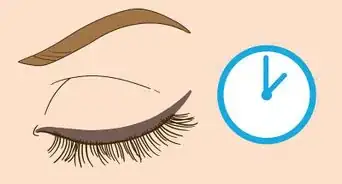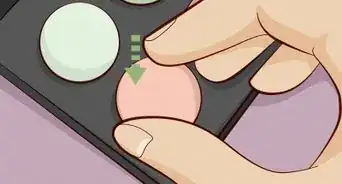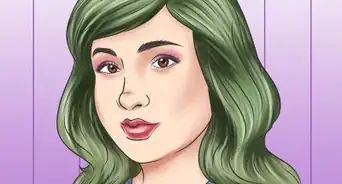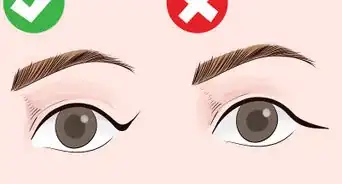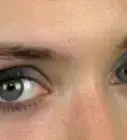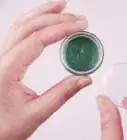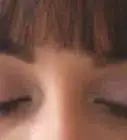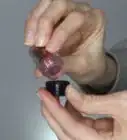This article was co-authored by Ashleigh Grounds and by wikiHow staff writer, Amy Bobinger. Ashleigh Grounds is a Makeup Artist and Hair Stylist based in Austin, Texas. Ashleigh has over 11 years of cosmetology experience. She studied cosmetology in Dallas, Texas and completed a two-year hair salon apprenticeship in Kuala Lumpur, Malaysia with Toni & Guy Hair Salon. She is accredited by the International Board of Cosmetology, is a certified Babe Hair Extension Professional, and is a certified Brazilian Blow Out Professional. Ashleigh was voted the best Hair Stylist in Austin for 2012 by RAW Artists and was voted in the top 20 salons for 2020 in Austin by Expertise. Ashleigh's work has been featured in Talentmagazines, BlogTalkRadio, KXAN, and Studio 512.
There are 11 references cited in this article, which can be found at the bottom of the page.
This article has been viewed 130,345 times.
Eyeshadow can seem like a tricky part of a makeup look. After all, there are so many different colors, not to mention the brushes. Luckily, even if you’re just starting to use makeup, choosing and applying eyeshadow can be easy. For everyday makeup you can wear to work or lunch with friends, try a natural eyeshadow look. If you want a more dramatic look for a night out, opt for a simple smokey eye that will only take a few minutes to create!
Steps
Creating a Natural Eyeshadow Look
-
1Choose a neutral color and a darker shade. All you’ll need to create a simple, natural eyeshadow look are 2 colors of eyeshadow—a base that’s similar to the color of your skin, and another that’s a few shades darker. While you can choose any colors you like, a neutral hue that complements your skin tone will look the most natural.[1]
- If you have fair skin, use a base shade that's just a little darker than your skin tone. If your skin is darker, opt for a color that's a little lighter than your skin, to make sure it pops.
- For example, if your skin is fair, then you might choose a champagne or light beige eyeshadow as a base color and light brown or taupe eyeshadow as your second hue. If you have a darker complexion, then opt for a caramel shade as your base and accent it with a dark copper shade.
-
2Swipe your brush lightly through the base color. Hold your eyeshadow brush between the thumb, index finger, and middle finger of your dominant hand, then brush the tips of the bristles lightly across the base color to pick up some of the pigment on the brush. It's better to start with less product and add more, so don’t press the brush into the shadow too hard.[2]
- Most eyeshadow palettes come with a sponge-brush applicator, or you can use a separate eyeshadow brush with bristles if you have one. Since this is a simple look, you'll get a similar effect no matter which type of brush you use.
- If you don't have a brush, use a cotton swab or a sponge applicator, instead.[3]
Advertisement -
3Remove excess powder by tapping the brush. Sometimes little flecks of eyeshadow powder can get caught on the surface your brush. This can lead to an uneven application. To avoid this problem, gently tap the side of your brush against the eyeshadow palette, your countertop, or even the back of your other hand.[4]
- Do this whether you're using a sponge brush or a bristle brush.
-
4Apply the base color all over your eyelid. Sweep the brush back and forth across your eyelid, starting from your lash line and blending your way up to your eyebrow. If you need to, apply a little more eyeshadow to the brush to ensure you get an even color, but make sure to concentrate the color along your lash line. Blend the brush upward, still moving back and forth, to just below your brow bone.[5]
- The color should fade slightly as it gets higher toward the crease. This will create a base for the rest of the look.
-
5Dust the brush across the darker powder and tap off any excess. Once you’ve applied the base eyeshadow color, sweep your brush across your darker color. Since the darker eyeshadow will typically show up better than the base color, try to pick up less of the darker shade.[6]
- A large shadow brush will work well for applying the first shade, but then you can switch to a smaller brush for the accent shade.
-
6Apply the dark shadow in the crease between your brow bone and eyelid. Sweep the brush in a half-moon shape that runs from the outside corner of your eye about 3/4 of the way down the crease of your eyelid. However, avoid putting the dark shade on the very inner corner of your eye, as this will make your eyes look smaller.[7]
- Keep sweeping the brush back and forth to blend in the color, or swipe your fingers across the area several times if you prefer. Don’t leave any harsh lines where the color stops.[8]
- If you have hooded eyes, try placing the darker shade just above the crease to create the illusion that your upper lids are more visible.
-
7Repeat the process for the other eye. It’s better to focus on one eye at a time, rather than switching back and forth. When you’re doing the second eye, try to make your eyeshadow look as close to the first eye as possible. Compare your eyes at the end to make sure they match, and make any changes that are needed.[9]
- To make sure you get the same color on both eyes, be sure to clean off any lingering color from the brush. You can do this by swiping the brush across a paper towel or the back of your hand.
- If your eyeshadow doesn't look the same on both eyes, use your finger, a brush, or a cotton swab to wipe away some of the eyeshadow on the eye that has a little more. This will give you a more natural result than if you add more eyeshadow to the eye with less color.
-
8Top with one coat of mascara to define your lashes. Eyeshadow powder can cling to your lashes, making them look lighter than normal. To counteract this, swipe on a coat of mascara. Brush the side of the wand against the tube to wipe off any excess mascara, then hold the mascara wand at the base of your lashes and wiggle it slightly. Finish by sweeping the brush up the length of your eyelashes all the way to the tip.[10]
- If you have lighter-colored lashes, brown mascara will look the most natural. If you have darker lashes, opt for black.
- For an even more natural look, use clear mascara, which will define your lashes without adding any color.
Trying a Simple Smokey Eye
-
1Sweep a dark shadow on your lids. Use an eyeshadow brush to sweep a dark shade of eyeshadow onto your lids going from your lashes to the crease. Opt for a dark color that you can pair with a medium and light shade of the same color, such as a charcoal with a medium grey and silver or a dark brown with a medium brown and beige.[11]
- When you're applying eyeshadow, the brush you use can affect the finished look. If you want a more pigmented look, use a dense brush. For a more subtle color payoff, use a softer brush, instead.[12]
- For more contrast, use a medium-dark shade, like a rich caramel or pewter color on your eyelid. Then, use a darker shade, like a coffee or slate-grey tone, along your crease.
-
2Apply a medium shadow on the crease. Next, sweep the medium shade over your crease going from the inner corner to the outer edge of your eye. This will begin to create a gradient effect going upwards.[13]
- Make sure to use your second darkest shade for the crease, such as a medium grey or medium brown.
-
3Sweep a light shadow on the browline. The last eyeshadow color you apply should be the lightest one. Sweep this color above your crease and up to your brow.[14]
- Opt for a shade with a bit of shimmer to highlight your eyes, such as a champagne with brown shades or silver with grey shades.
-
4Use your finger or a brush to blend the shadow up and out. Once the shadow is as dark as you’d like it, lightly run your fingertips or a clean brush over your eyes to blend the shadow. Always move the brush up toward above your crease and out to the corner of your eye, as this will have a lifting effect.[15]
- You can also blend your eyeshadow with a cotton swab if you’d like.
-
5Brush a light color onto the inner corner of your eye to highlight it. While this step isn’t necessary, it will create a pretty effect that emphasizes your smokey eye while making your eyes look brighter and bigger. Choose a very light color with a little iridescence or sparkle, like champagne or bright white, for the best highlighting effect.[16]
- If you used a cool color for your smoky eye, stick with a cool highlighting shade, and vice versa.
- If you’d like, you can also highlight just under the arch on your brows.
-
6Line your upper lids with eyeliner for a more dramatic look. You can wear a smokey eye with or without eyeliner, but you’ll get a more dramatic result if you do choose to use it. Whether you’re using a pencil liner or liquid, carefully apply the liner in a thin line along your upper lash line stopping about 2/3 of the way from the inner corner of your eye.[17]
- You can also apply a little of the main eyeshadow color beneath your lash line to define your eyes.
-
7Apply mascara to define your lashes. Finish your smoky eye with two coats of black mascara. Wipe the edge of the brush on the container to get rid of any excess mascara, then place the wand against the bottom of your lashes. Wiggle the wand slightly, then swipe the wand up along your lashes to the end. Repeat for the second coat.[18]
- If you’re using regular mascara, apply the second coat before the first has dried. If you’re using waterproof mascara, allow it to dry for a few minutes between coats.
- Using black mascara will give you the most dramatic lashes. However, if your lashes are very light, you may prefer the look of brown mascara, instead.
Picking the Right Eyeshadow
-
1Stick with a powder eyeshadow to start. Cream eyeshadows give you great coverage but are trickier to apply. If you’re just starting out, look for powder eyeshadows, instead.[19]
- Luckily, powder eyeshadows are by far the most common option, and you can find them in any makeup aisle.
-
2Determine your skin tone and undertone before you choose eyeshadow colors. Your skin tone is how light or dark it is. Finding your undertone, or whether your skin is cool or warm, can be a little trickier. While standing in natural light, look at the veins in your wrist. If they look blue or purple, you probably have cool undertones. If your veins look greenish, your undertones are probably warm. If you can’t tell, you probably have a neutral undertone.[20]
- Opt for warm colors like peach, caramel, gold, and milk chocolate if you have warm undertones.
- Choose cooler shades like taupe, grey, and dark chocolate if your undertones are cool.
- Any of these shades will probably look good on you if your undertones are neutral.
-
3Stick with a neutral palette when you're just getting started. With so many options out there to choose from, it can be tempting to jump right in and start playing with bright, bold colors. However, those shades will be a lot more noticeable if your technique is off. Practice with neutral colors, such as cream, beige, or chestnut, then play around with more adventurous shades once you feel comfortable.[21]
-
4Use light, shimmery colors to highlight your eyes if you are fair skinned. As you play with different looks, practice drawing attention to different parts of your eye to see what looks the best with your eye shape. For instance, a shimmery white or cream-colored shadow at the center of your eye will bring attention to your iris, whereas highlighting under your brow will make your eyes look more lifted.[22]
- Highlighting the inner corner of the eye will make your eyes look larger and more open.
- Shades with at least a little iridescence are best for highlighting, since they reflect light.
- Avoid putting shimmery shades anywhere with wrinkles, as this will emphasize them.
- Keep in mind that light shimmery shades will be more dramatic on darker complexions.
-
5Give definition to your eye with colors that contrast with your skin tone. If you are fair-skinned, use darker colors to contour your eye to give it the shape you want it to have. If you have a darker complexion, opt for light colors to define your eyes and add contrast. For instance, if your skin is fair, then enhancing your crease with a taupe or coffee-colored shadow will make your eyes look more sultry.[23]
- Also, adding dark shadow to the outer corners of your eyes can help camouflage fine lines.
Expert Q&A
Did you know you can get expert answers for this article?
Unlock expert answers by supporting wikiHow
-
QuestionHow do you make eyeshadow look natural?
 Ashleigh GroundsAshleigh Grounds is a Makeup Artist and Hair Stylist based in Austin, Texas. Ashleigh has over 11 years of cosmetology experience. She studied cosmetology in Dallas, Texas and completed a two-year hair salon apprenticeship in Kuala Lumpur, Malaysia with Toni & Guy Hair Salon. She is accredited by the International Board of Cosmetology, is a certified Babe Hair Extension Professional, and is a certified Brazilian Blow Out Professional. Ashleigh was voted the best Hair Stylist in Austin for 2012 by RAW Artists and was voted in the top 20 salons for 2020 in Austin by Expertise. Ashleigh's work has been featured in Talentmagazines, BlogTalkRadio, KXAN, and Studio 512.
Ashleigh GroundsAshleigh Grounds is a Makeup Artist and Hair Stylist based in Austin, Texas. Ashleigh has over 11 years of cosmetology experience. She studied cosmetology in Dallas, Texas and completed a two-year hair salon apprenticeship in Kuala Lumpur, Malaysia with Toni & Guy Hair Salon. She is accredited by the International Board of Cosmetology, is a certified Babe Hair Extension Professional, and is a certified Brazilian Blow Out Professional. Ashleigh was voted the best Hair Stylist in Austin for 2012 by RAW Artists and was voted in the top 20 salons for 2020 in Austin by Expertise. Ashleigh's work has been featured in Talentmagazines, BlogTalkRadio, KXAN, and Studio 512.
Makeup Artist & Hair Stylist
-
QuestionHow do you apply eyeshadow for beginners?
 Laura MartinLaura Martin is a Licensed Cosmetologist in Georgia. She has been a hair stylist since 2007 and a cosmetology teacher since 2013.
Laura MartinLaura Martin is a Licensed Cosmetologist in Georgia. She has been a hair stylist since 2007 and a cosmetology teacher since 2013.
Licensed Cosmetologist
-
QuestionHow do you apply light makeup for beginners?
 Laura MartinLaura Martin is a Licensed Cosmetologist in Georgia. She has been a hair stylist since 2007 and a cosmetology teacher since 2013.
Laura MartinLaura Martin is a Licensed Cosmetologist in Georgia. She has been a hair stylist since 2007 and a cosmetology teacher since 2013.
Licensed Cosmetologist
Things You'll Need
Creating a Natural Eyeshadow Look
- 1 light eyeshadow color
- 1 dark eyeshadow color
- Eyeshadow brush, sponge applicator, or finger
- Mascara
Trying a Simple Smokey Eye
- 1 dark eyeshadow color
- Mascara
- Eyeshadow brush, sponge applicator, or finger
- 1 light color for highlighting (optional)
- Eyeliner (optional)
Tip
- Applying a light layer of eyeshadow primer before you put on your eyeshadow will help make the color go on more evenly and last longer. It will also help prevent it from creasing.
- Cover dark circles beneath your eyes with concealer if you want to wear darker eyeshadow looks without your eyes looking too heavy.
References
- ↑ https://www.realsimple.com/beauty-fashion/makeup/eyes/apply-eye-shadow
- ↑ https://www.wellandgood.com/good-looks/how-to-apply-eyeshadow/
- ↑ https://www.self.com/story/eyeshadow-tips-for-beginners
- ↑ https://stylecaster.com/beauty/how-to-apply-eyeshadow-tutorial/slide1
- ↑ https://stylecaster.com/beauty/how-to-apply-eyeshadow-tutorial/slide1
- ↑ https://www.realsimple.com/beauty-fashion/makeup/eyes/apply-eye-shadow
- ↑ https://www.realsimple.com/beauty-fashion/makeup/eyes/apply-eye-shadow
- ↑ https://www.wellandgood.com/good-looks/self-care-holiday-gift-guide-beautycounter/
- ↑ https://www.realsimple.com/beauty-fashion/makeup/eyes/apply-eye-shadow
- ↑ https://www.allure.com/gallery/most-common-mascara-mistakes#slide=4
- ↑ https://www.cosmopolitan.com/style-beauty/beauty/how-to/g3016/smoky-eye-how-to/
- ↑ Ashleigh Grounds. Makeup Artist & Hair Stylist. Expert Interview. 22 April 2020.
- ↑ https://www.cosmopolitan.com/style-beauty/beauty/how-to/g3016/smoky-eye-how-to/
- ↑ https://www.cosmopolitan.com/style-beauty/beauty/how-to/g3016/smoky-eye-how-to/
- ↑ https://www.cosmopolitan.com/uk/beauty-hair/makeup/advice/a48863/how-to-apply-eyeshadow/
- ↑ https://www.goodhousekeeping.com/beauty/makeup/a35631/how-to-apply-eye-makeup-guide/
- ↑ https://www.cosmopolitan.com/style-beauty/beauty/how-to/g3016/smoky-eye-how-to/
- ↑ https://www.cosmopolitan.com/style-beauty/beauty/how-to/g3016/smoky-eye-how-to/
- ↑ https://www.allure.com/story/how-to-blend-eyeshadow-tips
- ↑ https://www.cosmopolitan.com/uk/beauty-hair/makeup/advice/a48863/how-to-apply-eyeshadow/
- ↑ https://www.wellandgood.com/good-looks/how-to-apply-eyeshadow/
- ↑ https://www.cosmopolitan.com/uk/beauty-hair/makeup/advice/a48863/how-to-apply-eyeshadow/
- ↑ https://www.cosmopolitan.com/uk/beauty-hair/makeup/advice/a48863/how-to-apply-eyeshadow/
About This Article
To apply eye shadow, choose a lighter shade for your base and another slightly darker shade if you want to create a natural look. For example, if you have fair skin, go for a champagne base and light brown on top. When you’re ready to apply the shadow, hold your brush between your thumb, index finger, and middle finger, and run it through your base color. Then, sweep the brush across your eyelid to apply the base color. If large clumps of powder get caught on your brush, tap it on the side of your palette to remove them. After your base is complete, apply a smaller amount of dark powder in the crease between your brow bone and eyelid, since the dark color always shows up more clearly. You could also put on a layer of mascara if you’re worried about the powder making your lashes look too light. For tips from our Beauty co-author on how to create a simple smoky eye, keep reading!
-Step-1-Version-2.webp)
-Step-2-Version-2.webp)

-Step-16.webp)
-Step-17.webp)
-Step-18.webp)
-Step-19.webp)
-Step-20.webp)
